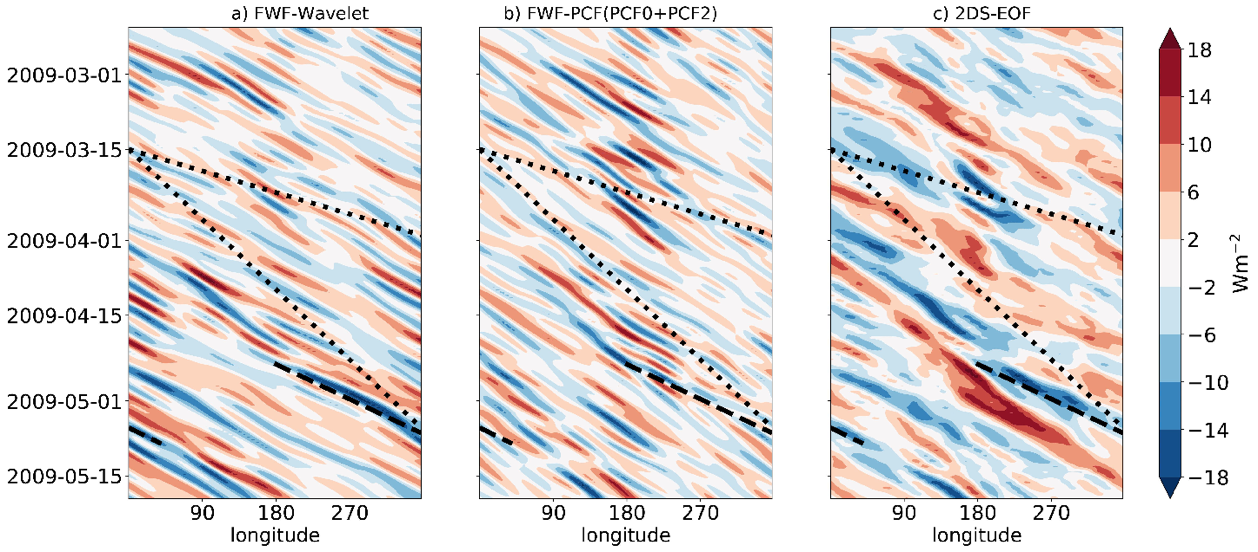How to measure the "pulse" of the tropical atmosphere?
The tropical atmosphere comprises a spectacular range of weather features, ranging from short-lived thunderstorms of few kilometres in diameter, tropical cyclones with diameters of a few 100 km to waves that span along the entire equator. More than 50 years ago, the Japanese meteorologist Taroh Matsuno developed a theoretical framework to understand and describe so called Equatorial waves (EWs) that is still widely used today. EWs are the mathematical solutions of a simplified set of equations that describe the tropical atmosphere. The different EW types propagate in the east-west direction and vertically with different speeds and horizontal structures. As they influence clouds, rainfall and wind, they are of major interest for weather forecasting in the Tropics. In the 1990s, Matsuno’s ideas were for the first time applied to satellite cloud data to provide evidence of the coupling of EWs with rainfall systems in the real atmosphere. During the last 25 years several new approaches have been developed to objectively identify EWs from wind, pressure, cloud and rainfall fields, emphasising different aspects of the waves.
Now a new paper has appeared in the well-respected Quarterly Journal of the Royal Meteorological Society that for the first time systematical compares six different EW identification methods in a case study and climatological context. “EWs have interested me for a long time, as they are so important for weather forecasting in the tropics”, states Peter Knippertz, the lead author of the new study, “but I had sometimes been puzzled about the seemingly inconsistent results by different approaches (see Figure).” During a sabbatical at Monash University in Melbourne (Australia) in 2020, the time was finally ripe to tackle the problem. Knippertz invited leading researchers working on EWs around the world to join in for the comparison project. “It was great to work with these excellent scientists “, he recalls, “but finding time for telecons was by no means trivial given that the members of the group live in seven different time zones”. “When we started, everyone was optimistic that the project could be completed during Peter’s sabbatical”, says Andreas Fink, one of three co-authors from KIT of the study, “but then we had to realize that the matter is much more complicated than we thought”.

The very comprehensive final result has turned out to be half way between review paper and original research, and hopefully can become a standard reference for all researchers interested in the topic. “Based on our results, we generally recommend employing a combination of methods and input fields to check for the robustness of the identified signal”, concludes Knippertz. In case of agreement one can have good confidence in the identified EW feature. In case of disagreement, one needs to carefully investigate which assumptions made for the individual methods are most probably not fulfilled. Ultimately, the new study will help researchers to choose an approach optimally suited to their problem at hand and avoid misinterpretation of the results.
Knippertz, P.; Gehne, M.; Kiladis, G. N.; Kikuchi, K.; Rasheeda Satheesh, A.; Roundy, P. E.; Yang, G.-Y.; Žagar, N.; Dias, J.; Fink, A. H.; Methven, J.; Schlueter, A.; Sielmann, F.; Wheeler, M. C., 2022: The intricacies of identifying equatorial waves. Quart. J. Roy. Meteorol. Soc., DOI: 10.1002/qj.4338
Working group: Atmospheric Dynamics
